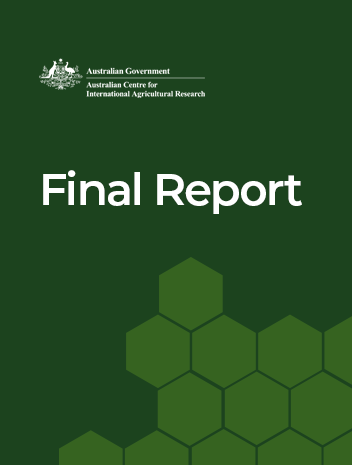- HomeHome
-
About ACIAR
- Our work
- Our people
-
Corporate information
- ACIAR Audit Committee
- Commission for International Agricultural Research
- Policy Advisory Council
- Agency reviews
- Executive remuneration disclosure
- Freedom of information (FOI)
- Gifts and benefits register
- Information publication scheme
- List of new agency files
- Contracts
- Legal services expenditure
- Privacy impact assessment register
- Commonwealth Child Safe Framework
- Benefits to Australia
- Careers
- 40 years of ACIAR
-
What we do
- Programs
- Cross-cutting areas
- Resources
- Where we work
-
Funding
- Research projects
- Fellowships
-
Scholarships
- John Allwright FellowshipScholarships to study in Australia for ACIAR partner country scientists to have Australian postgraduate qualifications
- ACIAR Pacific Agriculture Scholarships and Support and Climate Resilience Program
- Alumni Research Support Facility
- Publications
- News and Outreach
Project final report
Characterisation of Spodoptera frugiperda (fall armyworm) populations in South-East Asia and Northern Australia - Final Report
Date released
23 January 2023
ISBN
978-1-922787-65-1
Publication Code
FR2023-006
Overview
This project aimed to characterise armyworm populations in SEA and northern Australia crop production systems as the first step towards developing long-term management options.
The fall armyworm (FAW) Spodoptera frugiperda has caused major economic and social impact across Africa, Asia, and Oceania since its initial reported 2016 outbreak. The project (CROP/2020/144) aims to explore management options involving insecticides, IPM strategies, and cultural practices in Southeast Asia (SEA), and to understand and compare its population genetic diversity in SEA and Australia. By understanding genetic diversity, especially diversity in pesticide resistances, we aim to contribute to strategic management plans tailored for SEA and Australia farmers.
Whole genome sequencing of FAW from SEA (Myanmar, Vietnam, Lao PDR, Malaysia, Philippines), East Asia (South Korea) and Pacific (Papua New Guinea) showed significant genomic diversity between populations. This was reflected also in Australia’s (i.e., Oceania) FAW populations due to Australia’s close geographic proximity to SEA. FAW populations from SEA, East Asia, Pacific/Oceania, Africa and other Asia regions all showed signatures of admixture, supporting the invasive populations as overwhelmingly belonging to hybrids of R- and C-strains. A general lack of genetic connectivity between the early-stage northern Australia’s FAW populations suggested multiple introduction pathways to Australia.
The FAW genome resources generated from this project will:
- assist with understanding of future gene flow between different FAW populations, and
- contribute to future development and implementation of national and regional management strategies especially relating to economically (insecticide resistance, allelochemical detoxification) and environmentally (relating to climate stressor adaptation, heat and drought tolerance, low temperature tolerance) important genetic traits.
To this end, a simple metabarcoding approach was developed to demonstrate concurrent surveys of genetic diversity (relating to C- or R-strain haplotypes), and proportions of organophosphate/carbamate resistance allele frequencies from field FAW populations.
This project highlighted the global implication of pest incursions at local scales, especially for highly mobile species such as the FAW. Asia and SEA FAW likely contributed to establishment of Australia and some East African populations.
With Australia’s greater scientific capability, assistance to ASEAN communities to bolstering regional agricultural biosecurity could be a cost-effective solution to increase Australia’s own national biosecurity preparedness against exotic and emerging agricultural pests and diseases.
Insecticide and Bt bioassay experiments between Australia and SEA suggested populations from different geographic regions responded differently to insecticides. The project explored cultural management practices undertaken by SEA countries and how these compared with East Africa with similar approaches between Uganda and various SEA countries reported.
Progress was made to educate farmers through government/NGOs/inter-government-led awareness campaigns. While the initial FAW outbreak caused anxiety among small-scale farmers, international collaborative effort to educate and help farmers to implement management strategies are giving back confidence and building resilience to the future management of this pest.



